Hubble spots large elliptical galaxy about 73 million light-years from Earth

This celestial beauty captured by the NSA/ESA Hubble Space Telescope is a lenticular galaxy known as NGC 3156, which lies about 73 million light-years from Earth, in the minor equatorial constellation Sextans - a small constellation that belongs to the Hercules family.
A lenticular galaxy falls somewhere between an elliptical and a spiral galaxy. They have the central bulge and disk, a common feature of spiral galaxies but lack arms. Just like ellipticals, these galaxies have older stellar populations and little ongoing star formation. One theory suggests that lenticular galaxies are older spirals with faded arms while another proposes that they are formed from mergers of spiral galaxies.
The galaxy in question appears to be formed of faint, grey, concentric ovals growing progressively brighter towards the core, where there is a very bright point, and fading away at the edge.
Sextans is named after the instrument known as the sextant - an astronomical tool shaped like one-sixth of a circle, approximately the shape of the constellation - to measure angles in the sky.
"Sextants are no longer in use in modern astronomy, having been replaced by instruments that are capable of measuring the positions of stars and astronomical objects much more accurately and precisely. NGC 3156 has been studied in many ways other than determining its precise position — from its cohort of globular clusters, to its relatively recent star formation, to the stars that are being destroyed by the supermassive black hole at its centre," the European Space Agency wrote in a blog post.
📷 This NASA/ESA @HUBBLE_space Telescope shows the lenticular galaxy NGC 3156, 'lenticular' meaning that it falls somewhere between an elliptical and a spiral galaxy 👉 https://t.co/VltsbqLjM5 pic.twitter.com/yNuxupQfQK
— ESA (@esa) September 11, 2023
- READ MORE ON:
- Hubble Space Telescope
- lenticular galaxy
- Sextans










